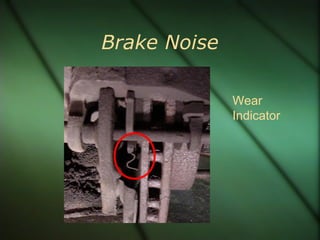Brakes____Best explained
- 2. Types Parking Brake Service Brake Hydraulic Disc Brakes Drum Brakes Dual System Antilock Brake System (ABS)
- 3. Parking Brake Not an “Emergency” Brake Used specifically to keep a parked vehicle from moving Usually on rear wheels only Mechanically operated Static Friction: at rest friction- More friction Kinetic Friction: in motion friction- less friction
- 5. Service Brakes Primary Braking System Should be stronger than the engine Hydraulic Operated Can be Vacuum, Hydro or Motor assisted Disc System Drum System Dual System
- 7. Hydraulic Principles Fluids cannot be compressed Fluids can transmit Movement Acts “Like a steel rod” in a closed container Master cylinder transmits fluid to wheel cylinder or caliper piston bore. Fluids can transmit and increase force Force Area Pressure
- 8. Hydraulics Simplified Hydraulic Brake System Drum Brake Master Cylinder Disk Brake Simplified Hydraulic Brake System Drum Brake Master Cylinder Disk Brake
- 9. Hydraulic pressure is distributed equally in all directions
- 10. Same line pressure toSame line pressure to all wheelsall wheels
- 11. The Hydraulic pressure is theThe Hydraulic pressure is the same, but the applied force cansame, but the applied force can be changed by thebe changed by the piston sizepiston size
- 12. System Basics Hydraulic actuation allows multiplication of pedal force. In this system, a 10lb force on the pedal produces 360 lbs of force at the friction surface.
- 13. Brake Fluid Properties of Brake Fluid Does not thicken or thin with changing heat Must not boil Must be compatible with brake parts material Must lubricate internal parts Must not evaporate easily
- 14. Brake Fluid types DOT 3 and 4- Polyglycol based Most common Compatible with one another Inexpensive Destroys paint Ruined by moister DOT= Department of Transportation High #= High stands, quality and boiling point • DOT 5- • Silicone Based • Used only for heavy duty applications • Not Compatible with 4&3 • Very Expensive • Does not damage paint
- 15. Fluid Contaminates Moister- Lowers boiling point water boils @ 212*F DOT 3 boils @ 401*F Petroleum Based Product- soften rubber parts causing swelling Dirt & Debris- causes corrosion and clogs Air and Vapors- Compressible prevents pressure from reaching brakes
- 16. Master Cylinder Provides a reservoir for brake fluid and contains the driving pistons in the hydraulic circuit 2 Types Front - Rear split -One piston for front brakes and one for rear -If a leak occurs you could lose front brakes Diagonally split -One piston drives one front wheel and one rear wheel -Diagonal layout allows you to maintain directional control if a leak occurs
- 17. Power Booster in closed position
- 18. Drum Brakes Expanding shoes create force on the inner surface of the drum Used on the rear of some trucks and SUV’s Self-energizing design requires less activation force Require periodic adjustment
- 20. Vented Rotors Vented Rotors have Fins in the spaces between their machined surfaces. These spaces allow air to pass through, which helps carry heat away.
- 21. Nonvented Rotor Non Vented Rotors are used on smaller vehicles, and have no cooling fins
- 23. Caliper Types There are 2 types of Calipers Fixed Calipers are disc brakes that use a caliper that is FIXED in position and does not slide. They have pistons on both sides of the disc. There may be 2 or 4 pistons per caliper Floating Much more common Single Piston Easier to work with On “inboard” side of caliper
- 24. Fixed Caliper •Motorcycles and some trucks and cars use this type •Similar to bicycle brakes
- 25. Sliding Caliper Applies pressure to two pads on opposite sides of rotor Caliper Sliding Fixed Friction Material exposed to air
- 26. Fixed Caliper Applies two pistons to opposite sides of rotor Caliper stays stationary Disc Brakes require higher hydraulic pressure
- 27. Diagnosis Several different types of Complaints Noise Pulsation Pedal travel More later…
- 29. Brake Pulsation Usually a warped Rotor Rotor needs trued on a brake lathe
- 30. Pedal Travel NO BRAKES!!!! •Excessive pedal travel •Pedal feels soft and squishy •Requires excessive effort to stop vehicle or my cause brakes to not function at all
- 31. Anti-Lock Brakes A locked (sliding) wheel offers less braking force than a decelerating rolling wheel The locked wheel also produces little lateral force, preventing steering control Anti-Lock systems (ABS) monitor wheel lock-up and modulate brake pressure to provide controlled braking under most circumstances
- 32. Anti-Lock Brakes System can have 2, 3 or 4 channels Trucks typically use 3 channel with only one sensor for the rear axle Most modern cars use 4 channel system Wheel speed sensors monitor each wheel speed ABS controller and high-pressure pump increase or reduce pressure to wheels in order to maintain consistent wheel speeds
- 33. Other Braking Systems Air Brakes Exhaust Brakes Electric or Trailer Brake

































